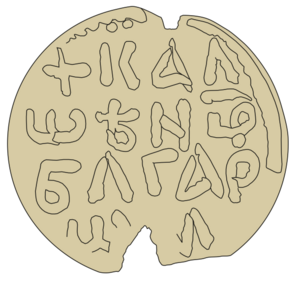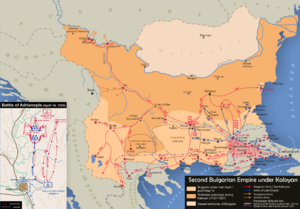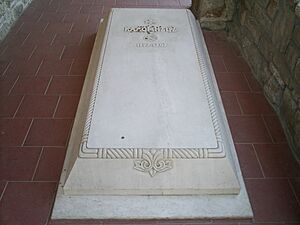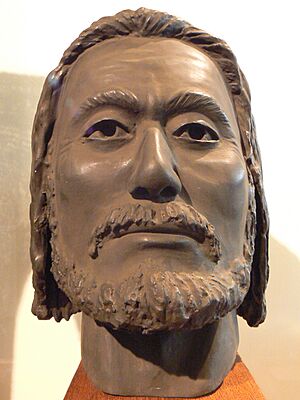Kaloyan of Bulgaria facts for kids
Quick facts for kids KaloyanКалоян |
|
|---|---|
|
|
| Reign | 1196 – 1207 |
| Coronation | 1196 |
| Predecessor | Ivan Asen I |
| Successor | Boril |
| King of the Bulgarians and Vlachs | |
| Reign | 1204 – 1207 |
| Coronation | 8 November 1204 |
| Born | c. 1170 |
| Died | October 1207 Thessalonica |
| Spouse | Cuman princess |
| Issue | Maria |
| Dynasty | Asen dynasty |
Kaloyan (born around 1170 – died October 1207) was an important ruler of the Second Bulgarian Empire. He was the younger brother of two emperors, Theodor and Asen. They led an uprising against the Byzantine Empire in 1185. This uprising brought back Bulgaria's independence.
Kaloyan became the ruler of Bulgaria in 1196 and ruled until 1207. He was also known as "the Romanslayer." This nickname came after his victory at the siege of Varna in 1201. He used this name to show he was an avenger, like the Byzantine emperor Basil II the Bulgar Slayer.
Kaloyan wanted to be recognized as an emperor by the Holy See (the Pope). He wrote to Pope Innocent III and offered to accept the Pope's authority. His goal was to expand Bulgaria's lands. This led to conflicts with the Byzantine Empire, Hungary, and Serbia. In 1204, a special envoy from the Pope crowned Kaloyan "king of the Bulgarians and Vlachs." However, Kaloyan still called himself a tsar (emperor).
Kaloyan took advantage of the fall of Constantinople in 1204. This happened when Crusaders (also called "Latins") took over the Byzantine capital. Kaloyan captured many fortresses in areas like Macedonia and Thrace. He also supported local people who rebelled against the Crusaders. In 1205, he defeated Baldwin I, the Latin Emperor, at the Battle of Adrianople. Baldwin was captured and later died in Kaloyan's prison. Kaloyan continued his campaigns against the Crusaders and Greeks. He died mysteriously in 1207 while trying to capture Thessalonica.
Contents
Early Life and Rise to Power
Kaloyan was the younger brother of Theodor and Asen. They started a big uprising against the Byzantine Empire in 1185. Theodor became emperor and took the name Peter. Asen became his co-ruler. They made Bulgaria independent with help from Cuman warriors.
Kaloyan was born around 1170. His baptism name was Ivan, but people called him Johannitsa, meaning "Little Ivan." This was because his older brother Asen was also named Ivan. The name Kaloyan came from a Greek phrase meaning "John the Handsome." His enemies sometimes called him "John the Dog."
In 1188, Kaloyan was sent to Constantinople as a hostage. This was part of an exchange for Asen's wife. He later escaped and returned home around 1189. In 1196, a nobleman named Ivanko murdered Asen. Ivanko tried to take the throne with Byzantine help. But Theodor-Peter forced him to flee. Kaloyan then became the sole ruler of Bulgaria in 1197 after Theodor-Peter was also murdered.
Conflicts and Imperial Ambitions
Fighting the Byzantine Empire
After becoming ruler, Kaloyan immediately attacked the Byzantine province of Thrace. He launched many raids there. Around this time, he wrote to Pope Innocent III. He wanted the Pope to recognize him as the ruler of Bulgaria. The Pope was eager to connect with Kaloyan. He hoped to unite Christian churches under his power.
Kaloyan captured several Byzantine cities, including Braničevo, Velbuzhd, Skopje, and Prizren. This likely happened around 1198. In late 1199, the Pope's envoy arrived in Bulgaria. The Pope said that Kaloyan's ancestors came from Rome. Kaloyan replied, calling himself "Emperor of the Bulgarians and Vlachs." He said he was the rightful successor to earlier Bulgarian rulers. He asked the Pope for an imperial crown. He also wanted the Bulgarian Orthodox Church to be under the Pope's authority.
In 1201, Kaloyan and his Cuman allies attacked Byzantine lands again. He destroyed Constantia and captured Varna. He also supported rebellions against the Byzantine Emperor Alexios III. Later, Kaloyan made a peace treaty with Alexios III. He withdrew his troops from Thrace. Alexios III also seemed willing to send Kaloyan an imperial crown.
Seeking a Royal Crown
In 1202, Kaloyan helped Stefan, a Serbian prince, against his brother Vukan. Kaloyan allowed Cumans to invade Serbia. He also invaded Serbia himself and captured Niš in 1203. Emeric, King of Hungary, who claimed some of these lands, got involved. The Hungarian army occupied areas that Kaloyan also wanted. The Pope urged Kaloyan to make peace with Hungary. In September, the Pope's envoy gave a special cloth to Basil I, the head of the Bulgarian Church. This confirmed Basil's rank as archbishop, but not as patriarch.

Kaloyan was not happy with the Pope's decision. He sent another letter to Rome. He asked the Pope to send cardinals to crown him emperor. He also told the Pope that Hungary had taken five Bulgarian bishoprics. He wanted the Pope to help settle the border dispute. In this letter, he called himself "Emperor of the Bulgarians." The Pope did not agree to an imperial crown. However, he sent Cardinal Leo Brancaleoni to Bulgaria in 1204 to crown Kaloyan as king.
Meanwhile, Crusaders were attacking Constantinople. Kaloyan offered them military help if they would crown him king. But the Crusaders ignored his offer. On April 13, 1204, the Crusaders captured Constantinople. They chose Baldwin IX of Flanders as their new emperor. They also decided to divide the Byzantine Empire among themselves.
The Pope's cardinal, Brancaleoni, was arrested in Hungary. He was only released after the Pope demanded it. On November 7, Brancaleoni made Basil the head of the Bulgarian and Vlach Church. The next day, Brancaleoni crowned Kaloyan as king. In his letter to the Pope, Kaloyan called himself "King of Bulgaria and Vlachia." But he still referred to his kingdom as an empire and to Basil as a patriarch.
War with the Crusaders
Defeating the Latins
Kaloyan took advantage of the Byzantine Empire's collapse. He captured former Byzantine lands in Thrace. He first tried to divide the lands peacefully with the Crusaders (Latins). He asked Pope Innocent III to stop them from attacking Bulgaria. But the Crusaders wanted to keep all the lands they had agreed to divide. These lands included areas Kaloyan claimed.
Kaloyan gave shelter to Byzantine refugees. He encouraged them to start rebellions against the Latins in Thrace and Macedonia. The people of Adrianople and other towns rebelled against the Latins in early 1205. Kaloyan promised to send them help. Emperor Baldwin decided to attack Kaloyan first. He began to besiege Adrianople. Kaloyan quickly arrived with a large army of Bulgarians, Vlachs, and Cumans. On April 14, 1205, Kaloyan's army defeated the Crusaders in the Battle of Adrianople. They used a trick where the Cumans pretended to retreat. This drew the Crusader knights into an ambush.
Baldwin was captured during the battle. He later died in Kaloyan's prison in Tarnovo. Some historians say Kaloyan killed Baldwin out of anger. Others say Baldwin's head was used as a drinking cup. However, Baldwin's brother, Henry, said Kaloyan treated the captured Crusaders with respect.
After his victory, Kaloyan's troops raided Thrace and Macedonia. He attacked the Kingdom of Thessalonica. He besieged Serres in May. He promised the defenders safe passage, but he broke his word and took them captive. He continued his campaign, capturing Veria and Moglena. Many people in Veria were killed or captured. Henry, who was ruling the Latin Empire, counter-attacked in June. He could not capture Adrianople.
Kaloyan decided to punish the people of Philippopolis. They had helped the Crusaders. With the help of local Paulicians (a Christian group), he captured the town. He ordered the most important citizens to be killed. The common people were taken as prisoners to Vlachia. He returned to Tarnovo after a rebellion against him. He punished the rebels harshly. In January 1206, he invaded Thrace again. He captured Rousion and killed its Latin soldiers. He then destroyed most fortresses along the Via Egnatia. The local people were captured and moved to the lower Danube region. After these events, Kaloyan called himself "Romanslayer." This was a clear reference to Basil II, who was called "Bulgarslayer" after destroying the First Bulgarian Empire.
The Greeks in Thrace and Macedonia were outraged by the massacres. They realized Kaloyan was more hostile than the Latins. The people of Adrianople and Didymoteicho offered to surrender to Henry. Henry accepted and helped them. Kaloyan attacked Didymoteicho in June, but the Crusaders forced him to stop. After Henry was crowned emperor, Kaloyan returned and destroyed Didymoteicho. He then besieged Adrianople, but Henry forced him to leave. Henry also invaded Bulgaria and freed 20,000 prisoners.
Kaloyan made an alliance with Theodore I Laskaris, the Emperor of Nicaea. Laskaris was fighting another emperor, David Komnenos, who was supported by the Latins. Laskaris convinced Kaloyan to invade Thrace. This forced Henry to move his troops from Asia Minor. Kaloyan besieged Adrianople in April 1207. He used large siege machines, but the defenders held out. A month later, the Cumans left Kaloyan's army. This forced Kaloyan to lift the siege. Pope Innocent III urged Kaloyan to make peace with the Latins, but he did not listen.
Henry made a truce with Laskaris in July 1207. He also met with Boniface, King of Thessalonica. Boniface accepted Henry's authority. However, on his way back to Thessalonica, Boniface was ambushed and killed in September. Some say local Bulgarians did it and sent Boniface's head to Kaloyan. Others say Kaloyan planned the ambush. Boniface's young son, Demetrius, became king. His mother, Margaret, took over the kingdom's rule. Kaloyan quickly went to Thessalonica and began to besiege the town.
Death of Kaloyan
Kaloyan died during the siege of Thessalonica in October 1207. The exact reasons for his death are not clear. Historian George Akropolites said he died of a lung illness. Akropolites also mentioned a rumor that Kaloyan died because of "divine wrath." It was said that an armed man appeared in his dream and struck him with a spear.
Stories about Saint Demetrius of Thessalonica helping the besieged city appeared soon after Kaloyan's death. One story says the saint himself came to Kaloyan's tent and "struck him with a lance through the body." Another story says a man on a white horse struck Kaloyan with a lance. Kaloyan thought the attacker was Manastras, the commander of his soldiers. Manastras then had to flee before Kaloyan died. This legend is shown in paintings in several Orthodox churches. For example, a painting in the Decani Monastery shows Saint Demetrius killing "Tsar Skaloyan."
Because of these different stories, many historians believe Kaloyan was murdered. Some think Manastras killed him, possibly hired by Kaloyan's wife and nephew, Boril. Others believe the Greeks convinced Manastras to turn against the tsar.
Kaloyan's Grave
The exact location of Kaloyan's grave is unknown. Some stories say his body was prepared and taken to Tarnovo. In 1972, a golden ring was found near the Church of the Holy Forty Martyrs in Tarnovo. The ring has the inscription "Kaloyan's ring." Some historians believe this means Kaloyan's remains were moved to the church. However, this is debated because the ring might be from the 14th century, not Kaloyan's time. Also, other royals buried there are inside the church, not outside. This suggests the ring might have belonged to someone else named Kaloyan from a later time.
Based on a skull found in the same grave, an anthropologist created a reconstruction of Kaloyan's face. However, the skull's identity is also debated.
Family Life
Kaloyan's wife was a Cuman princess. They had one known daughter, whose name is not known. After Kaloyan died, his widow married his successor, Boril. Boril later married Kaloyan's daughter to the Latin Emperor Henry in 1211.
See also
- Kaloyan Nunatak






